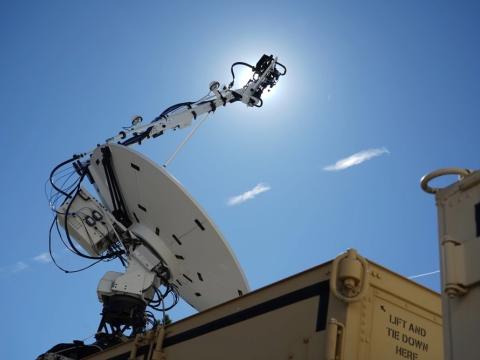Battlefield Crime Scene Investigators Gather Evidence To Stop Terrorists
 |
Weapons Intelligence Team (WIT) 18 destroys improvised explosive device materials it recovered earlier. After WITs complete exploitation of these items, they dispose of the materials by detonation to deny insurgents reuse. |
Joint-service weapons intelligence teams around
Sailors, soldiers and airmen compose the weapons intelligence teams (WITs), which serve as battlefield crime scene investigators. Master Sgt. Dustin Colgate, USAF, Multi-National Division–Baghdad WIT superintendent, says the work does not precisely mirror popular television crime scene investigators; rather, the teams process post-blast improvised explosive device (IED) sites to gather data necessary to combat the weapons. Though efforts focus mostly on IED events, WITs also work on other weapon crime scenes. The WIT teams exist only in
Five military individuals from specialty careers including explosive ordnance disposal (EOD), intelligence analysis, Master at Arms (police) and photography, generally compose the teams. A team lead, usually an EOD technician who educates the team on all aspects of the disposal actions, is designated for each group. The actual team positions are shared in a fused team effort. Sometimes additional personnel such as linguists expand teams’ numbers, but specialties such as language skills are so sought-after that available personnel are scarce.
Team members also can fill roles in addition to their own (for example, an analyst taking photographs) when necessary. The military strives for continuity on the teams, training members of the unit together in a special course at
When a WIT responds to an incident, the goal is to have the right combination of skills to examine the crime scene and collect evidence for intelligence and prosecution. Team members take forensic photographs and collect forensic evidence such as fingerprints. These are analyzed elsewhere so legal teams can build cases for prosecution of the weapon users in either
The WITs’ work is almost entirely responsive, with the only preventive efforts coming in the form of training. Master Sgt. Colgate says he cannot speak in detail about how teams are called to respond, but he can explain that the Iraqis request assistance with facilitating and exploiting crime scenes. In addition, provisions are in place for WITs to respond to events involving coalition forces.
The difficulty of predicting enemies’ movement makes prevention a hard task. The analysis part of the WIT effort examines past events and creates intelligence so coalition forces better understand insurgent tactics. However, foreseeing exactly what the adaptive, agile enemy will do is difficult. Master Sgt. Colgate says forces cannot predict what will happen, but the push on the back end of WITs’ efforts is to garner evidence to improve planning and response. Information gleaned from response actions can be shared among various WITs as well as processed to look at trends.
According to Master Sgt. Colgate, the intelligence piece of WITs’ work offers advantages to troops and operations. Insight into the enemy’s actions helps coalition forces make better decisions and provides key insight into insurgents’ abilities and techniques. “This is the best we can do predictively,” he says. “This is one of the definite benefits of our mission.” With the information, the military can alert members to potential problems especially prevalent in their area. “That helps our security teams and convoys modify,” Master Sgt. Colgate states. “That saves lives.”
Evidence gathered during WIT site analysis goes to the Combined Explosives Exploitation Cell where it is processed. Detention packages are created from the information in the analysis, and law enforcement personnel then can arrest perpetrators.
The collection and preparation of evidence as well as review analysis and the generation of intelligence reports are major ways WITs differs from EOD. Most troops, including ordnance troops, have little experience with forensics, which is one reason for all the training WIT members undergo. The teams do work with EOD units, entering blast areas after EOD technicians give the all clear. “EOD enables us to do our job,” Master Sgt. Colgate says.
EOD and WIT personnel learn from each other as well, which improves coalition operations and changes reactions to events. The master sergeant explains that many of the IED sites WIT teams investigate are similar, but there are surprises such as different constructs or tactics. “It’s really surprising to me how innovative and adaptive these guys are,” he says. “It’s a scary thing we’re trying to combat.”
Counteracting the agility of the insurgents requires flexibility on the part of the military. “We have to be willing to modify if necessary,” Master Sgt. Colgate states. “You can never stagnate—you can only build on your knowledge. The enemy is constantly evolving, and we have to do the same and try to better that. We have to best that evolution.”
He adds that the military is challenged to remain two steps ahead of the bad guys. Part of that attempt means not losing sight of what needs to be accomplished when troops encounter new situations. “I think how we react to the events is the [key] takeaway,” Master Sgt. Colgate states. WIT members have to be careful to do their jobs correctly even when dealing with a unique situation, because if they perform a task incorrectly it could interfere with the ability to process evidence.
 |
A WIT member collects evidence at an explosion site. |
Since the troop drawdown in
WIT members are demonstrating to their Iraqi counterparts the processing of evidence and chain of custody as well as how to mark evidence from Point A to Point B. Through the knowledge sharing, the Iraqis learn how to use forensic evidence in a courtroom to show that a perpetrator is associated with a crime.
WIT personnel are trained in best practices to ensure evidence is processed according to
The master sergeant says the military is pleased with how the training is progressing and that the military is trying to up the ante as the time for troop withdrawal moves closer. “We’ve allocated resources to the specific role to educate Iraqi security forces, police and officials on this evidence and how to make sure it’s viable,” he explains. He says that the work builds a partnership legacy important to all involved, and that the effort allows
Master Sgt. Colgate calls the Iraqi-U.S. partnership exciting.
However, the expansion and willingness to share expertise can result in the dismantling of WITs. Sometimes team members are called away from their teams to attach to and assist Iraqi units or when another team, such as EOD, might need a special skill of a WIT member. “That’s key to helping spread our knowledge and our skills,” Master Sgt. Colgate says. However, it also is a relatively new condition for teams to break up instead of remaining constant. “We still try to keep that team integrity, but a lot of times we’ll farm our guys out,” he explains.
Often the single entities will partner with Iraqis posted at austere locations who otherwise would not obtain hands-on experience. Master Sgt. Colgate labels this work as a success of the WITs in
Most of the time when team members leave their WITs, they remain attached to the other unit. “There’s such a need, and WIT has proven so valuable, they’re requested to stay,” the master sergeant explains. This forces the military to split up WITs, but Master Sgt. Colgate says the teams are trying to help people. The requests for WIT members have resulted from the teams’ maturation over time as their missions have solidified. One of the early challenges they faced was proving their abilities. “Now people are demanding our services,” Master Sgt. Colgate says.
WITs have been so successful that the Army is trying to determine how to make it a more enduring capability perhaps by creating a unique military operational specialty. Master Sgt. Colgate explains that the concept definitely is being looked at because there is so much of a need for the skills.
WEB RESOURCES
Multi-National Force–Iraq: www.mnf-iraq.com




Comments